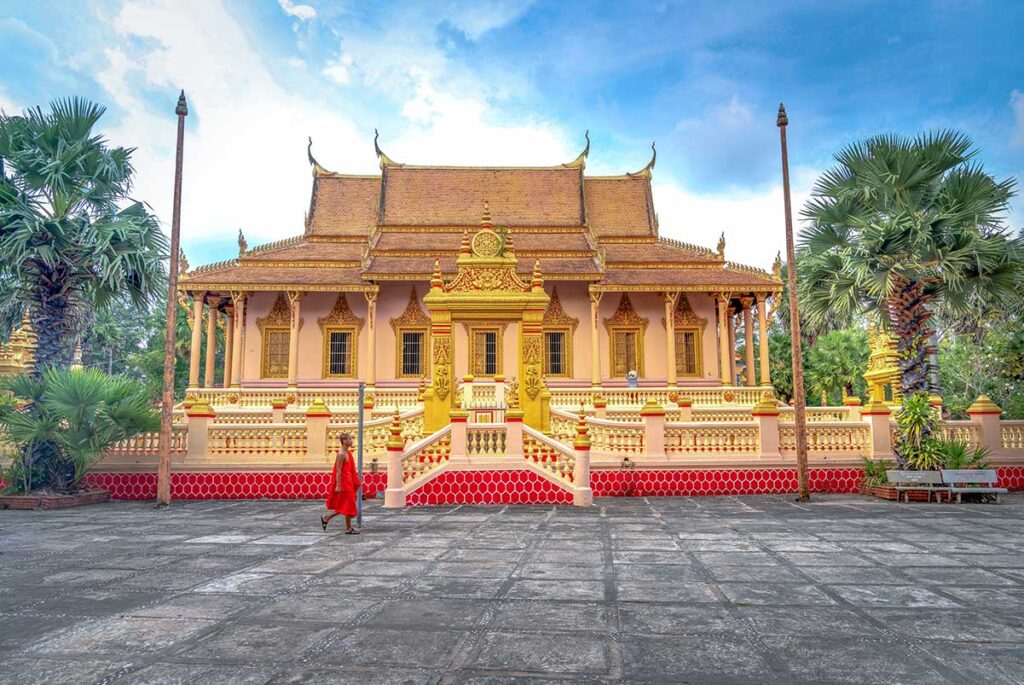What is Kh’leang Pagoda
Overview & Setting
Kh’leang Pagoda (Wat Kleang) is a Khmer Theravada Buddhist temple located in the heart of Soc Trang city. Despite being in an urban center, its spacious grounds shaded by palm and plumeria trees create a calm, almost village-like atmosphere. The pagoda covers several hectares, offering both a place of worship and a leafy retreat.
History & Name
The temple dates back to the early 1500s, with construction recorded around 1532–1533. Its first version was built simply from wood and thatch before being rebuilt more solidly with brick and tile. The name Kh’leang in Khmer translates to “rice storage,” reflecting the agrarian roots of the community that established it. Recognized as a national architectural heritage site, the pagoda is one of the oldest Khmer temples in the Mekong Delta.
Architecture & Style
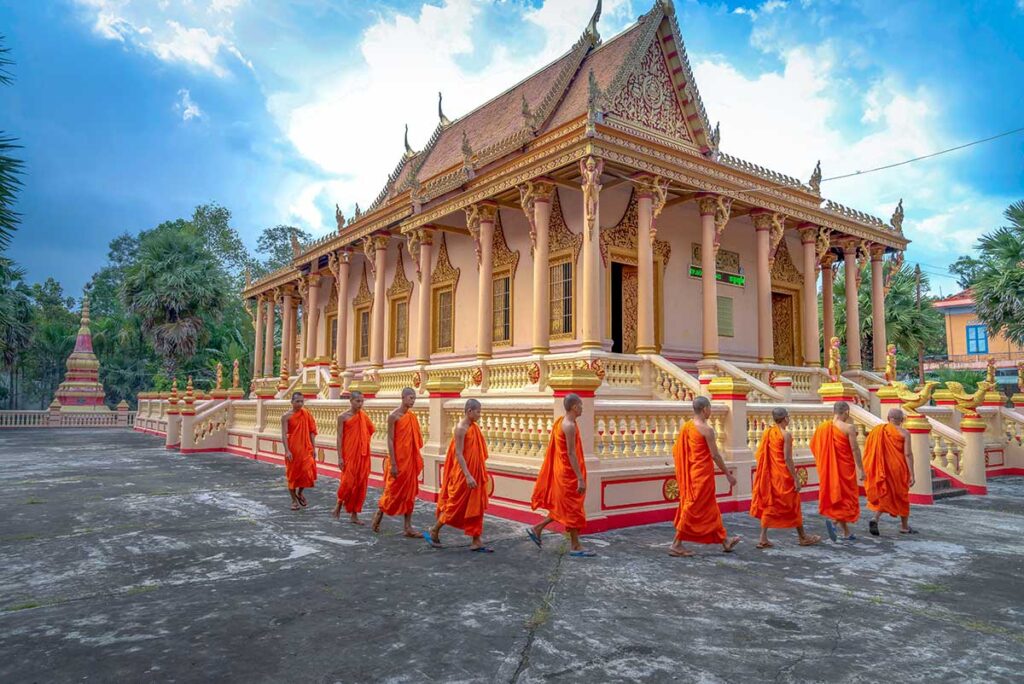
Kh’leang Pagoda is an excellent example of Southern Khmer religious architecture. The main hall, stupas, and auxiliary houses feature motifs common in Khmer culture—mythical guardians, dragons, and lotus-shaped decorations. Some details, such as dragon and carp carvings or Chinese script, reveal Vietnamese and Chinese artistic influences over the centuries. Several structures are inspired by traditional Khmer stilt-house designs, with raised platforms and wooden detailing.
Role in community today
Far from being a relic, Kh’leang Pagoda remains a living religious and cultural hub. Monks reside here, and the grounds host the Southern Pali Secondary School, where Buddhist teachings are studied. Each summer, monks also provide free Khmer language and ethics classes for local children, strengthening cultural identity. The pagoda is an active center for rituals, festivals like Chol Chnam Thmay and Ok Om Bok, and charity activities that support the wider community.
Highlights of visiting Kh’leang Pagoda
1. The Angkor-Style Gate
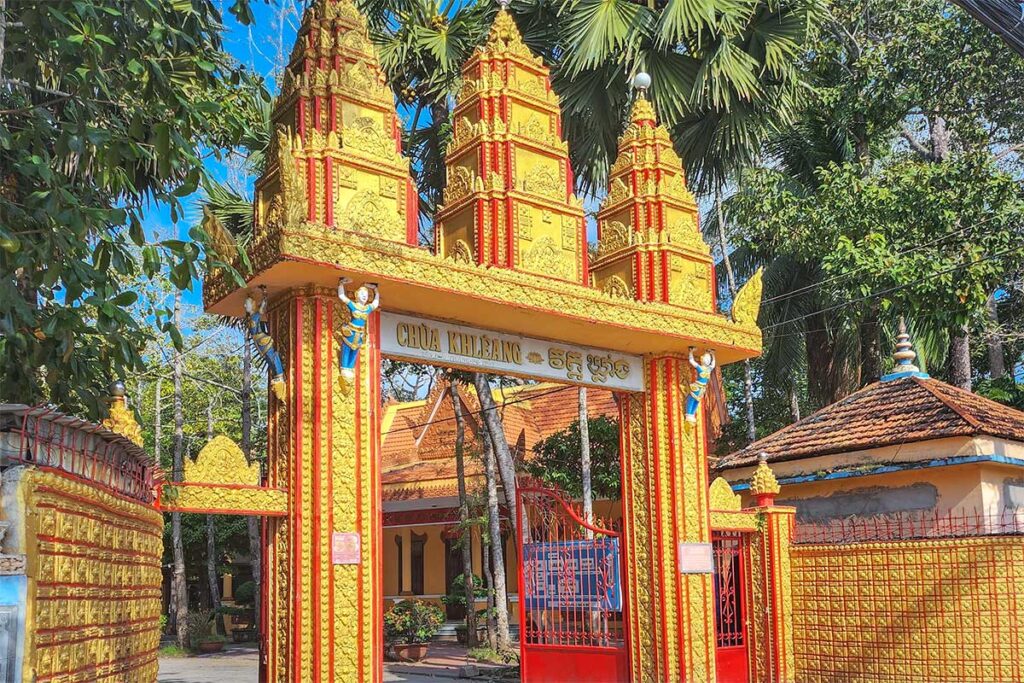
The first thing you see is the ornate Khmer-style entrance gate, built in the style reminiscent of Angkor temples. With tiered spires, golden carvings, and Khmer script above the archway, it sets the tone for the pagoda’s cultural identity. Though not as elaborate as the main hall, it’s a striking introduction and one of the most photographed parts of the complex.
2. The Main Hall (Vihara)
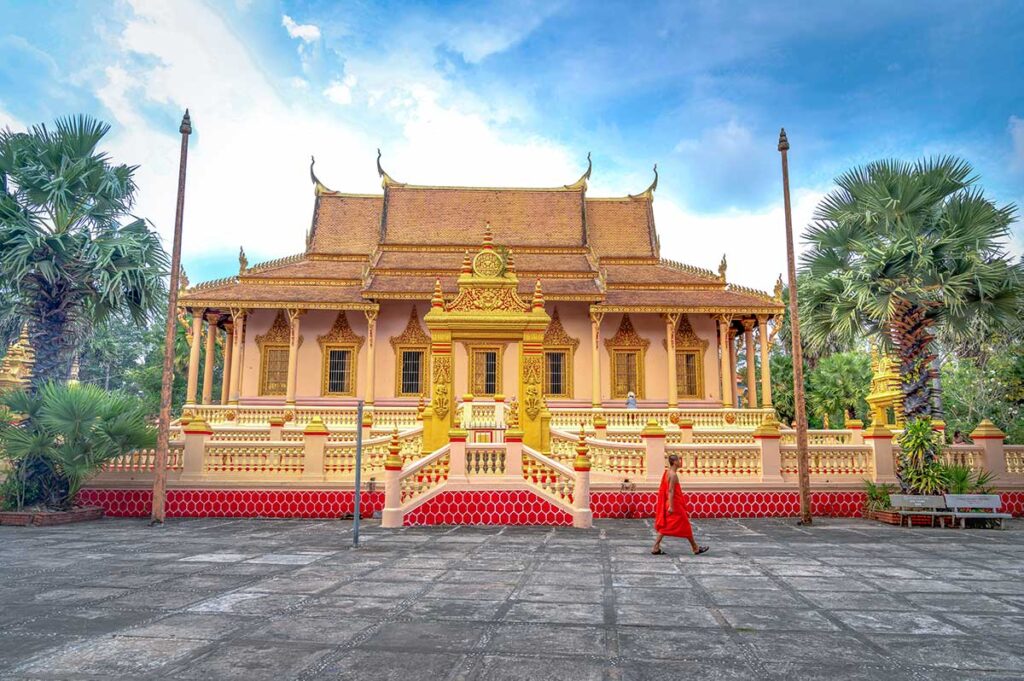
The main hall is the heart of Kh’leang Pagoda and the building with the richest details. Raised on a three-step platform, it immediately stands out from the garden around it. At the staircases and balustrades, you’ll notice guardian figures: fierce Yeak demons with bulging eyes, mythical birds, and naga motifs winding along the railings. These guardians are a classic feature of Khmer Buddhist temples, representing the protection of the Dharma.
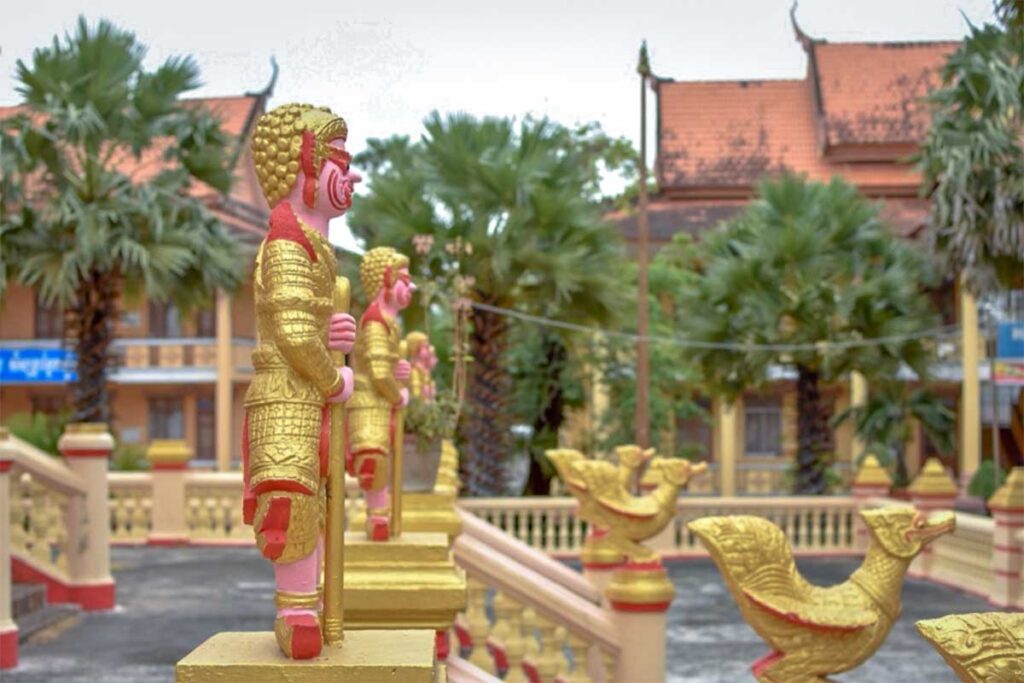
Looking upward, the multi-tiered rooflines are decorated with dragons and nagas curling at the edges, while the Krud (Garuda) — a bird-like figure biting the tail of a snake — appears at the roof corners. This detail is symbolic of the eternal struggle between good and evil and ties the temple visually to Khmer traditions across Cambodia and Thailand.
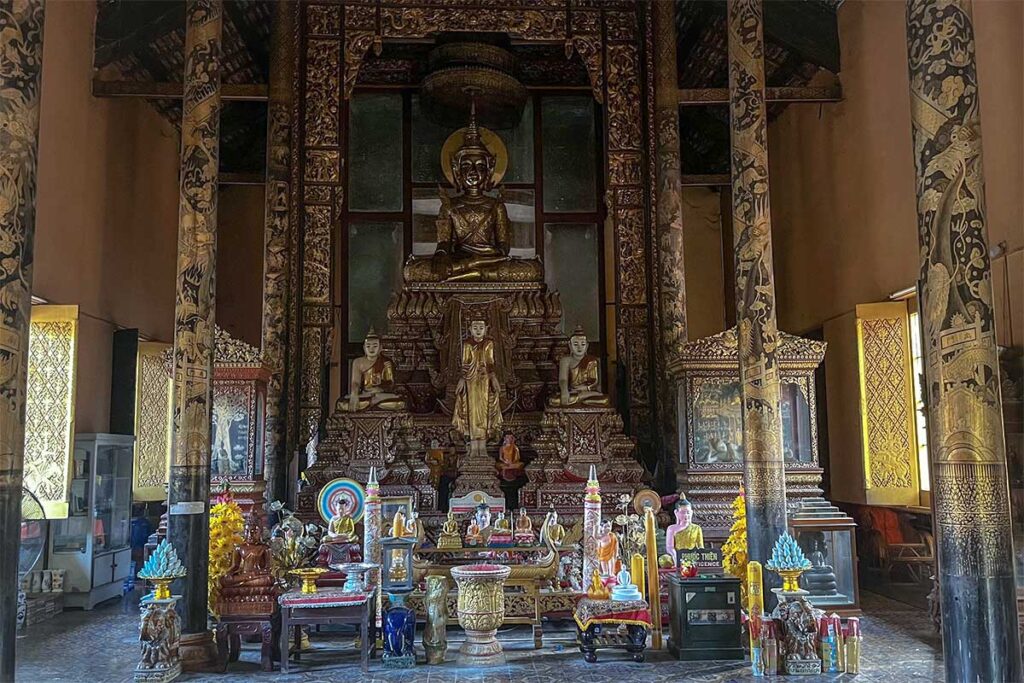
Inside the hall, tall dark-wood columns rise from the floor, each lacquered black and decorated with gold-leaf images from the life of the Buddha. The central focus is a large Buddha statue seated on a lotus pedestal, surrounded by light and smaller statues. The hall feels solemn yet intimate, a space that encourages quiet observation of the artwork as much as prayer.
3. Sala & Stilt-House Inspired Structures
Elsewhere in the compound are halls built in the style of Khmer stilt-houses, raised slightly and supported by wooden pillars. These sala halls serve as meeting spaces and places for chanting or teaching. Their simpler design contrasts with the ornate main hall, but they show how Khmer architectural traditions extend beyond purely ceremonial buildings.
4. The Southern Pali Secondary School
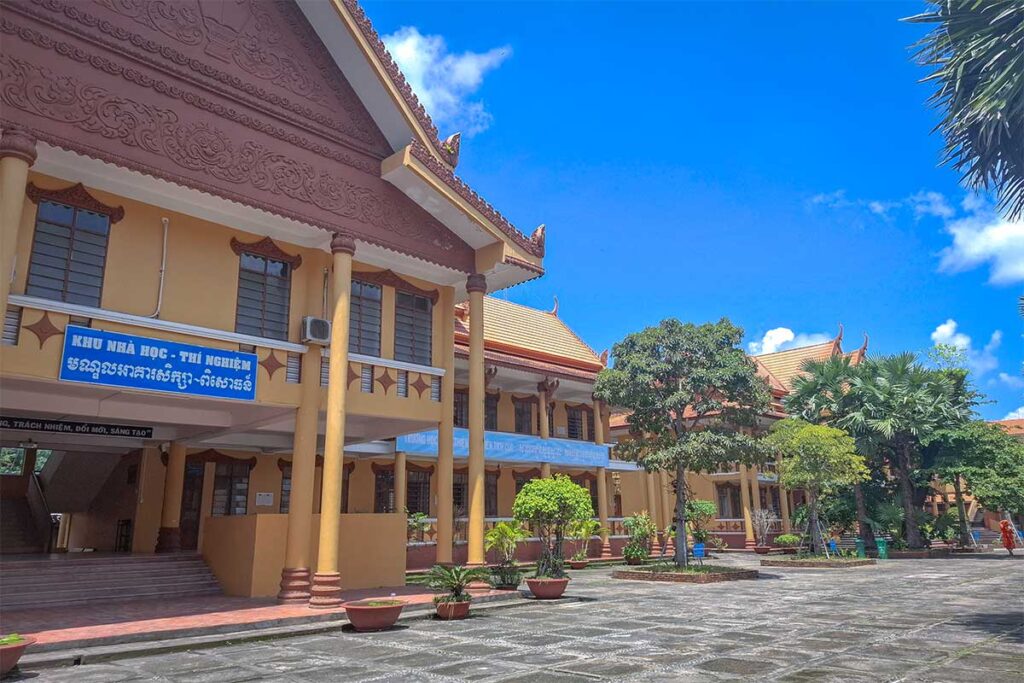
One unique aspect of Kh’leang Pagoda is its role as an educational center. Within the grounds is the Southern Pali Secondary School, where monks and novices study Theravada Buddhism and the Khmer language. During summer, the school also offers free classes in Khmer language, culture, and ethics for children from the community. The presence of classrooms and young novices gives the pagoda a lively, lived-in atmosphere that sets it apart from temples visited only for rituals.
5. Stupas & Memorials
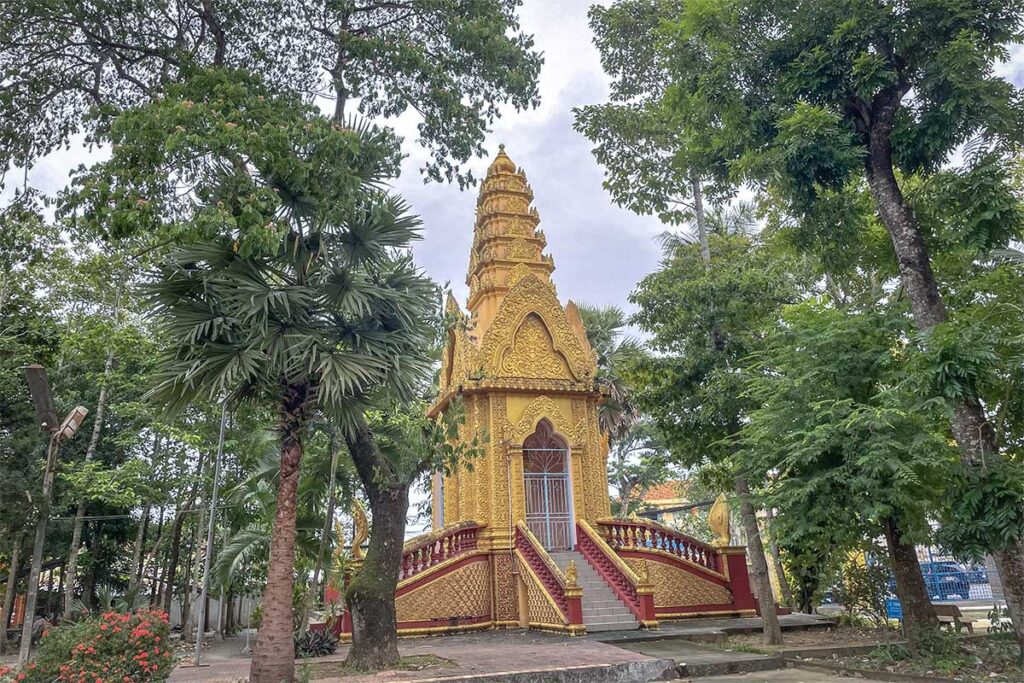
Scattered around the grounds are several stupas, built to enshrine the ashes of monks and respected patrons. Some are small and plain, while others are larger and more decorative, with lotus and naga details carved into their sides. For the Khmer community, these stupas are both memorials to the dead and reminders of the Buddhist teaching of impermanence.
6. Garden setting
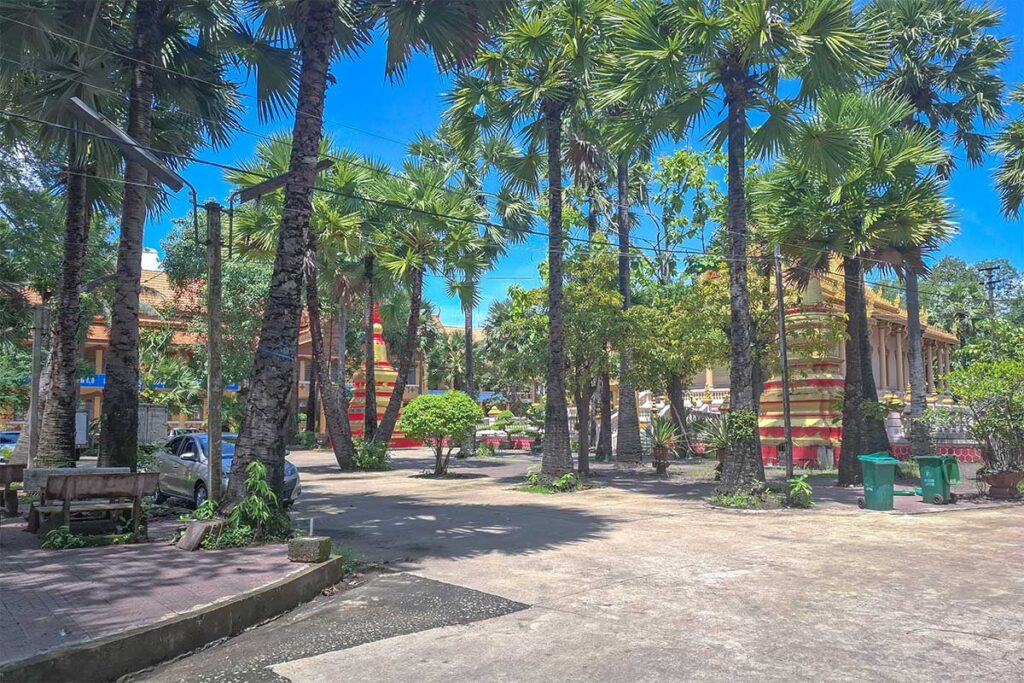
The pagoda is set in a tranquil garden shaded by tall sugar palms and flowering plumeria. These trees are closely tied to Khmer life in the Mekong Delta and give the grounds a peaceful atmosphere, especially compared to the bustle of Soc Trang city outside the walls. The leafy setting makes it a pleasant place to pause between exploring the temple’s architectural details.
7. Monastic life & Learning
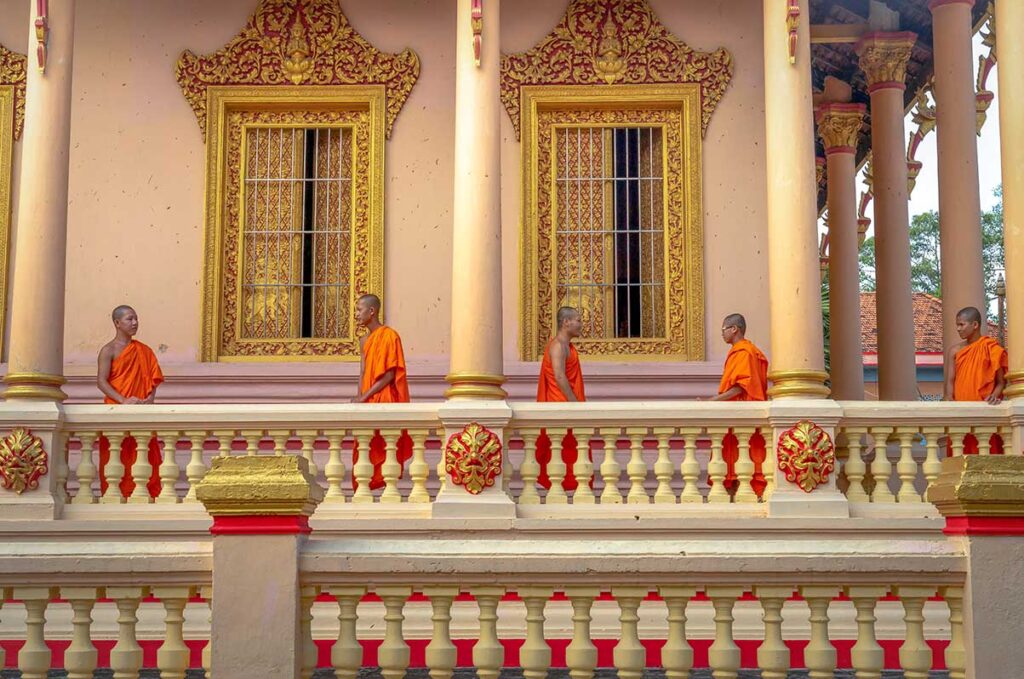
Kh’leang Pagoda is not just a monument — it is home to an active Khmer monastic community. Monks and novices in bright orange robes can often be seen studying, chanting, or simply tending to the grounds. For many visitors, this is one of the most striking experiences: seeing monks in Cambodia- and Thailand-style robes within Vietnam, highlighting how unique the Khmer cultural presence is here. During summer, the sight of children learning in classrooms adds another layer of authenticity to the pagoda’s daily life.
Location & Getting there
Where is Kh’leang Pagoda?
Kh’leang Pagoda is located on Ton Duc Thang Street in Ward 6, right in the center of Soc Trang city. Its central position makes it easy to combine with other nearby temples, markets, and the Khmer cultural museum.
Getting to Soc Trang
Soc Trang is about 60 km south of Can Tho and around 230 km from Ho Chi Minh City. The most common way to get here is by intercity bus or minivan, with frequent departures from both cities. Travel time is roughly 1.5–2 hours from Can Tho or 5–6 hours from Ho Chi Minh City. The roads are mostly flat and in decent condition, though traffic can be busy near larger towns. For more comfort and flexibility, many travelers choose a private car transfer, which allows for stops along the way.
Getting to the Temple
- Cycling – Soc Trang is flat and compact, so cycling is an option, though mid-day heat can be challenging. Early morning or late afternoon rides are more pleasant.
- Scooter/Motorbike – Renting a motorbike is an easy way to get around town. The pagoda is central, and there’s space to park outside—just do so respectfully.
- Taxi/Grab – Taxis and ride-hailing apps like Grab are widely available in the city, offering a quick and hassle-free way to reach the temple.
- Private Car – Ideal if you want to explore several temples in one trip, or if you’re coming in directly from Can Tho or another city.
Practical visiting information & Tips
Opening times & Access
The temple grounds are generally open during daylight hours. While you can freely walk around, access to the main hall depends on the schedule of ceremonies and the discretion of the monks. There is no entrance fee, but a small donation at the box provided is appreciated and helps with upkeep.
Best time of day & How long you need
Visiting in the early morning or late afternoon is ideal, when the light is softer, the heat less intense, and the temple grounds quieter. Most travelers spend 30–60 minutes here, though those interested in details of the architecture or photography may stay longer.
Dress code & Etiquette
As with other Buddhist temples, modest clothing is expected—cover shoulders and knees. Remove hats when entering halls, keep your voice low, and avoid touching altars, statues, or offerings. If you wish to take photos of monks or novices, ask politely first.
Photography notes
Photography is welcome outdoors, but avoid using flash inside the main hall and refrain from disrupting ceremonies. The best angles include the guardian statues at the entrance, the roofline with naga and Krud motifs, the gilded wooden columns, and the lotus-patterned fence around the hall.
Safety & Comfort
The garden provides good shade, but the climate is humid—carry water and wear sun protection. Be mindful of uneven steps, especially on the raised three-tier platform. Dogs sometimes wander the grounds; it’s best not to approach or feed them.
Accessibility
Paths are not always smooth, and the steps to the main hall can be a challenge for those with limited mobility. There are few ramps or facilities for wheelchairs.
Festival considerations
If you visit during major Khmer festivals such as Chol Chnam Thmay (New Year) or Ok Om Bok (Moon Festival), expect larger crowds and lively activities. It’s a vibrant time to experience Khmer culture, but less suited if you’re looking for a tranquil visit.
Facilities
Restroom facilities, if available, are basic. Carry tissues and hand sanitizer just in case. There are no cafés or shops inside the grounds, so plan for water and snacks before or after your visit.
What is nearby to combine
Soc Trang is home to one of the largest Khmer communities in Vietnam, and Kh’leang Pagoda sits at the heart of this cultural cluster. A visit here can easily be paired with other temples, museums, and local experiences, making for a rewarding half-day or full-day itinerary.
- Bat Pagoda (Chùa Dơi / Mahatup) – Famous for its resident bat colony and striking Khmer-style design, this is the most visited temple in Soc Trang after Kh’leang.
- Clay Pagoda (Chùa Đất Sét) – A unique temple where thousands of clay sculptures, candles, and figurines decorate the interiors, built entirely by a single devoted monk.
- Khmer Cultural Exhibition Center / Museum – Located just across the street from Kh’leang Pagoda, this small museum displays palm-leaf manuscripts, traditional costumes, and ritual objects that give context to Khmer life in the Mekong Delta.
- Soc Trang city walk – The city center is compact, with lively markets, Khmer and Vietnamese snacks, and relaxed street food options that make for an easy wander.
- Day trips in the province – If you have more time, consider an early start to visit Nga Nam Floating Market, explore rural Khmer pagodas, or take in the rice-field scenery that surrounds the city.
Is Kh’leang Pagoda worth to visit?
Kh’leang Pagoda is a peaceful and authentic Khmer Theravada temple, making it one of the clearest windows into Khmer religious art and community life in Vietnam. Its guardian statues, gilded columns, and shady garden setting give it a distinctive atmosphere that feels both sacred and welcoming.
If you’ve already visited Cambodia or Thailand, you may find the scale and ornamentation here more modest in comparison. Still, in the context of Vietnam, Kh’leang stands out as a unique cultural site—one of the few places where Khmer heritage is so visible and well preserved. For anyone exploring Soc Trang, it is very much worth including in your itinerary.
